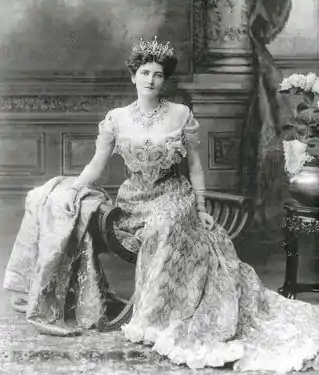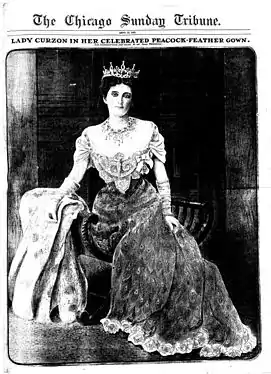Lady Curzon's peacock dress
Lady Curzon's peacock dress is a gown made of gold and silver thread designed by Jean-Philippe Worth for Mary Curzon, Baroness Curzon of Kedleston to celebrate the 1902 Coronation of King Edward VII and Queen Alexandra at the second Delhi Durbar in 1903.
 | |
| Artist | Jean-Philippe Worth (dress), Indian Zardozi workers (textile), William Logsdail (painting) |
|---|---|
| Year | 1903 |
The gown was assembled from panels of chiffon that had been embroidered and embellished by Delhi and Agra craftsmen, including the firm of Kishan Chand on the Chandni Chowk in Dehli[1] using the zardozi (gold wire weaving) method. It was then shipped to Paris, where the House of Worth styled the dress with a long train edged with white chiffon roses. The worked panels were overlapping peacock feathers that had a blue/green beetlewing at the center. Over time, the metal thread in the dress has tarnished but the beetle wings have not lost their luster.[2]
The Viceroy, Lord Curzon, organized the second Delhi Durbar in 1903 to celebrate the 1902 coronation of King Edward VII, "the grandest pageant in history", which created a tremendous sensation. The dress was featured in a Chicago Tribune article because Lady Curzon was from Chicago. State portraits were ordered from the artist William Logsdail, but Lady Curzon's portrait was completed in 1909 after her death in 1906. The peacock dress is preserved, together with the Logsdail portrait, at Kedleston Hall.
Lady Curzon was instrumental in promoting the use of Indian embroidery in Western fashion, and many of her friends ordered gowns from Worth using such decorations, though they generally used much less metal threadwork which weighed her dress down. According to its entry at Kedleston Hall, the peacock gown weighs 10 pounds. Another of her embroidered court dresses, assembled by the House of Worth in 1903, is on display at the Fashion Museum, Bath.
Gallery
 William Logsdail, 1909, George Nathaniel Curzon, Marquess Curzon, oil on canvas
William Logsdail, 1909, George Nathaniel Curzon, Marquess Curzon, oil on canvas William Logsdail, 1909, Mary Victoria Leiter, Lady Curzon, oil on canvas
William Logsdail, 1909, Mary Victoria Leiter, Lady Curzon, oil on canvas Albert Edward Jeakins, 1903, Lady Curzon wearing the peacock dress.
Albert Edward Jeakins, 1903, Lady Curzon wearing the peacock dress. front cover of the Chicago Tribune 27 September 1903
front cover of the Chicago Tribune 27 September 1903 Lord and Lady Curzon arriving at the Delhi Durbar in 1903
Lord and Lady Curzon arriving at the Delhi Durbar in 1903
 Jean-Philippe Worth for House of Worth, 1901-1903, court gown worn by Lady Curzon, Fashion Museum, Bath
Jean-Philippe Worth for House of Worth, 1901-1903, court gown worn by Lady Curzon, Fashion Museum, Bath Jean-Philippe Worth for House of Worth, 1901-1903, court gown worn by Lady Curzon, Fashion Museum, Bath
Jean-Philippe Worth for House of Worth, 1901-1903, court gown worn by Lady Curzon, Fashion Museum, Bath
References
- 17 January 1903. The Illustrated London Times. Page 8. "Our Illustrations The Delhi Durbar-Accident to Our Artist's Sketches." "Mr. Melton Prior...In addition to the notes which we print below Mr. Melton Prior's drawings, he writes with reference to the embroidery-factory: "Kishan Chand employs a native artist, who designs the patterns and walks about overlooking the men at work. Some of the old men shown in the sketch are, I am told, the finest workmen at their particular craft to be found in India. Their hours are comparatively easy, being from nine to five." " pg11 Chandni Chowk sketch by Melton Prior pg 19- "The Imperial Durbar at Dehli: The Impetus to Native Industries. Sketch (Facsimile) by Melton Prior, our Special Artist at Dehli." --"Natives Making the Durbar Dresses and Elephant-Trappings at the Principal Embroidery Factory Where Coronation Robes were made for Queen Alexandra. Mr. Melton Prior writes: "In the Chandni Chowk, at the workshop of Kishan Chand, the richest of the embroidery-merchants, I found his workpeople employed upon the magnificent robes for Lady Curzon and embroideries and trappings for the State elephants. It seemed at first almost impossible that the motley collection of workmen squatting on the floor at their crude and dusty frames could be the real producers of the splendid work I had seen. Yet so it was. I asked Kishan Chand how he guarded against pilfering, and he told me that the material supplied to each man, silk, velvet, and precious stones was weighed night and morning." Curtis, William Eleroy. Modern India. Published after 1903-1902. eBook can be found on Project Gutenberg. pg 254->"The descendants of the master workmen educated under this policy are still living and following the trades of their ancestors in Delhi, and there may be found the finest gold and silver cloth and the most elaborate embroidery produced in the world. The coronation robe of Queen Alexandra of England, which is said to have been of surpassing richness and beauty, was woven and embroidered in a factory upon the Chandni Chauk, and the merchant who made it is constantly receiving orders from the different courts of Europe and from the leading dressmakers of London, Paris and Vienna. He told us that Mrs. Leland Stanford had commissioned him to furnish the museum of her university in California the finest possible samples of different styles of Indian embroidery, and his workmen were then engaged in producing them. Her contract, he said, amounted to more than $60,000. Lady Curzon is his best customer, for she not only orders all of the material for her state gowns from him, but has brought him enough orders from the ladies of the British court to keep his shop busy for five years. He told us that Lady Curzon designed the coronation robe of Queen Alexandra; he declared that she had the rarest taste of any woman he knew, and that she was the best dressed woman in the world--an opinion shared by other good judges. He spread upon the floor wonderful samples of the skill and taste of his artists, brocades embroidered with jewels for the ceremonial robes of native princes; silks and satins whose surface was concealed by patterns wrought in gold and silver thread. And everything is done by men. Women do not embroider in India. He keeps eighty men embroiderers constantly employed, and pays them an average of 18 cents a day. The most famous of his artists, those who design as well as execute the delicate and costly garnishings, the men who made the coronation robe of the British queen, receive the munificent compensation of 42 cents a day. That is the maximum paid for such work. Apprentices who do the filling in and coarser work and have not yet acquired sufficient skill and experience to undertake more important tasks are paid 8 cents a day and work twelve hours for that...... Lord Curzon has used his official authority and the influence of the government to revive, restore and promote old native industries, and Lady Curzon has been an invaluable commercial agent for the manufacturers of the higher class of fabrics and art objects in India. She has made many of them fashionable in Calcutta and other Indian cities and in London, Paris and the capitals of Europe, and so great is her zeal that, with all her cares and responsibilities, and the demands upon her time, she always has the leisure to place orders for her friends and even for strangers who address her, and to assist the silk weavers, embroiderers and other artists to adapt their designs and patterns and fabrics to the requirements of modern fashions. She wears nothing but Indian stuffs herself, and there is no better dressed woman in the world. She keeps several of the best artists in India busy with orders from her friends, and is beginning to see the results of her efforts in the revival of arts that were almost forgotten..... And the durbar demonstrated the wisdom of those who planned it. The expense was quite large. The total disbursements by the government were about $880,000, and it is probable that an equal amount was expended by the princes and other people who participated. That has been the subject of severe criticism also, because the people were only slowly recovering from the effect of an awful famine. But there is another point of view. Every farthing of those funds was spent in India and represented wages paid to workmen employed in making the preparations and carrying them into effect. No money went out of the country. It all came out of the pockets of the rich and was paid into the hands of the poor. What the government and the native princes and nobles expended in their splendid displays was paid to working people who needed it, and by throwing this large amount into circulation the entire country was benefited. The extravagance of the Viceroy and Lady Curzon in their own personal arrangements has also been criticised, and people complain that they might have done great good with the immense sums expended in dress and entertainment and display, but it is easy to construe these criticisms into compliments, for everyone testifies that both the viceroy and his beautiful American wife performed their parts to perfection, and that no one could have appeared with greater dignity and grace."
- [Note: While Lady Curzon was commissioning her dress embroidery she was also tasked with the embroidery for three dresses for Queen Alexandria, each potentially for her coronation. Her letters describing this process are archived in the British Library in the India Office Records. Citations for which letters mention Queen Alexandria and Lady Curzon's involvement can be found in Inside the Royal Wardrobe: A Dress History of Queen Alexandria by Kate Eicher, Chapter Eight. See also citation on Queen Alexandria's Wikipedia page.]
- Embroidered gowns for Lady Curzon in the official catalogue of the 1903 Delhi Durbar
- Lady Curzon's peacock gown in the Chicago Tribune, 27 September 1903
- The Peacock Dress object record on the National Trust for Places of Historic Interest or Natural Beauty website
- Lady Mary Curzon's Peacock Dress featured on National Trust website for Kedleston Hall
- Lady Curzon's peacock dress on website of the Textile Research Center, Leiden
| Wikimedia Commons has media related to Lady Curzon's peacock gown. |